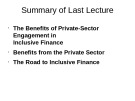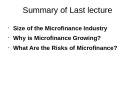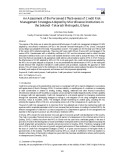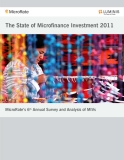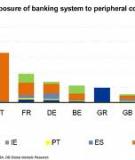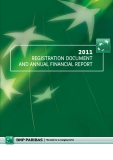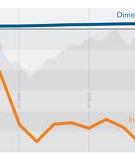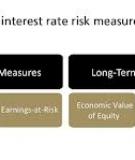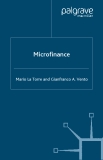
Risks of microfinance
-
Using panel data of 34 microfinance institutions in period of 5 years (2011-2015), this study is aimed to investigate the determinants of the Operational Self-Sustainability (OSS) of Vietnamese microfinance institutions. Therefore, to be more sustainable, MFIs should focus on its professionality and increase its equity. Other recommendations are proposed to related stakeholders for the enabling ecosystem for microfinance development - one important tool in poverty reduction and economic development.
 17p
17p  huyetthienthan
huyetthienthan
 23-11-2021
23-11-2021
 22
22
 2
2
 Download
Download
-
In this chapter, the following content will be discussed: Size of the microfinance industry, why is microfinance growing? what are the risks of microfinance? The benefits of private-sector engagement in inclusive finance, benefits from the private sector, the road to inclusive finance.
 42p
42p  nanhankhuoctai9
nanhankhuoctai9
 23-07-2020
23-07-2020
 17
17
 2
2
 Download
Download
-
In this chapter, students will be able to understand: Understanding clients, the market, and the opportunities; size of the microfinance industry; why is microfinance growing? what are the risks of microfinance?
 36p
36p  nanhankhuoctai9
nanhankhuoctai9
 23-07-2020
23-07-2020
 9
9
 1
1
 Download
Download
-
The purpose of the study was to assess the perceived effectiveness of credit risk management strategies (CRMS) adopted by microfinance institutions (MFIs) in the Sekondi-Takoradi Metropolis (STM), Ghana. Descriptive survey design was adopted for the study. The population was 261. The sample size for the study was 158 key staff of the various MFIs selected purposively.
 8p
8p  tociitocii
tociitocii
 24-04-2020
24-04-2020
 45
45
 1
1
 Download
Download
-
Investor base: about 70 percent of private bonds were purchased by banks in 2011. Their participation has increased further recently partly because they have faced constraints in expanding consumer loans given increased risk and higher cost in the sector, and therefore have sought alternative higher-yield investment instruments. Liquidity in the secondary market is very limited as many banks tend to hold private bonds until maturity. Retail investors’ participation remains low (see Figure 11). ...
 16p
16p  hongphuocidol
hongphuocidol
 04-04-2013
04-04-2013
 66
66
 8
8
 Download
Download
-
Progress Microfinance has been implemented through two actions, both of which are managed by EIF. They are: 1) a guarantee instrument to providers of micro-credit (funded entirely by the European Commission); and 2) a structured investment vehicle set up under Luxembourg law, the European Progress Microfinance Fund, funded by the European Commission and the EIB.
 100p
100p  khanhchilam
khanhchilam
 29-03-2013
29-03-2013
 88
88
 11
11
 Download
Download
-
The Progress Microfinance investment by the EIB is part of EIB Group’s long term financing role seeking to increase value added and catalyse funds in support of small companies. Progress Microfinance illustrates the enhanced cooperation between the EU and the EIB Group through innovative risk sharing structures with subordinated capital from the European Union, allowing higher leverage on the Community budget and subsequently greater market impact and providing value added to a still emerging market through more effective and efficient use of scarce budgetary funds. ...
 0p
0p  khanhchilam
khanhchilam
 29-03-2013
29-03-2013
 41
41
 8
8
 Download
Download
-
Another early-stage mandate in support of the European microfinance sector was the European Parliament Preparatory Action (“EPPA”), a EUR 4m envelope under which the EIF has, since April 2010, made four risk capital investments and loans to non bank MFIs. While these windows served as an opportunity for market testing, their pilot nature and limited scale and scope represented a constraint on the market impact that these EU initiatives could deliver.
 0p
0p  khanhchilam
khanhchilam
 29-03-2013
29-03-2013
 80
80
 8
8
 Download
Download
-
The impact of the crisis further increases the market failure – also driven by increased risk aversion on the supply side of microfinance - and underlines the need for public support for this emerging sector in Europe. In addition to the fundamental structural problems of the microfinance sector in Europe, public intervention has largely been justified and substantiated with positive externalities, i.e. that social and financial inclusion generates attractive economic and social returns.
 396p
396p  khanhchilam
khanhchilam
 29-03-2013
29-03-2013
 50
50
 10
10
 Download
Download
-
This reluctance on the part of mainstream lenders creates an opportunity for microfinance but also underlines the paramount importance of credit risk management in an industry that, in Western Europe at least, continues to be driven by socially motivated investors and entities supporting microfinance as part of their social responsibility initiatives. This realisation has a significant impact on the pricing of financing instruments to such types of entities and has arguably served to undermine the development of viable microfinance models in terms of self-sustainability.
 149p
149p  khanhchilam
khanhchilam
 29-03-2013
29-03-2013
 71
71
 9
9
 Download
Download
-
Microfinance institutions have been affected by the adverse macro-economic conditions during the global financial and economic crisis, generally through significantly higher bad debt rates among their clients and in some cases through increased difficulties in accessing external sources of funding.
 58p
58p  khanhchilam
khanhchilam
 29-03-2013
29-03-2013
 54
54
 7
7
 Download
Download
-
Standardised, regularly available indicators to explain market developments for microfinance in Europe do not yet exist, or refer to Eastern Europe. Thus, we will focus in this section on the framework conditions for microfinance which are covered by the regularly updated Eurostat indicators for poverty and social inclusion, and by data on micro-enterprises. Specific aspects of the current crisis will be discussed later in this paper.
 54p
54p  khanhchilam
khanhchilam
 29-03-2013
29-03-2013
 61
61
 9
9
 Download
Download
-
The greatest triumph of microfinance is the demonstration that poor households can be reliable bank customers. The received wisdom at the start of the 1970s held that substantial subsidies were required to run financial institutions serving poor households in low-income countries. Government banks often shouldered the task of serving the poor, usually with a focus on farmers. However, most state-run banks were driven by political imperatives, and so they charged interest rates well below market rates and even then collected loan repayments only half- heartedly.
 39p
39p  taisaovanchuavo
taisaovanchuavo
 23-01-2013
23-01-2013
 60
60
 7
7
 Download
Download
-
Microfinance International Corporation (MFIC). Since 2006 MFIC, a US-based financial services corporation, has partnered with microfinance lenders and remittance transaction operators in El Salvador, Guatemala, and the Plurinational State of Bolivia to provide transnational mortgage loans to immigrants in the United States and Spain. MFIC links remittances to housing microfinance. Partnering with two microfinance institutions (MFIs) — Apoyo Integral de S.V. and Sociedad Cooperativa de Ahorro y Crédito (AMC) — MFIC launched a pilot program in El Salvador in September 2006.
 12p
12p  machuavo
machuavo
 19-01-2013
19-01-2013
 37
37
 3
3
 Download
Download
-
A key observation of the paper is that neither the branch nor the subsidiary structure is obviously preferable in all cases from the financial stability perspective. The key to ensuring financial stability lies instead in the design of effective mechanisms to oversee and resolve cross-border banking groups. These include effective home/host supervision and information-sharing arrangements and satisfactory cross-border resolution regimes and burden- sharing agreements.
 28p
28p  machuavo
machuavo
 19-01-2013
19-01-2013
 58
58
 5
5
 Download
Download
-
Legislators/regulators should keep in mind that market making is a substantial part of the provision of financial products, like bonds (including governmental bonds), exchange traded funds, or investment certificates. Therefore, it seems reasonable from an economic perspective that these activities remain linked to the deposit taking activities. Due to their branch networks and other distribution channels, deposit taking banks are the main distributors of such financial instruments throughout the European Union.
 7p
7p  machuavo
machuavo
 19-01-2013
19-01-2013
 65
65
 4
4
 Download
Download
-
Moreover, poor women who have access to financial services have proven themselves to be highly creditworthy. Anecdotal evidence indicates that women repay their loans more consistently than do men. Necessity has made women careful strategists who plan for the future, shrewd risk-takers with an eye for economic opportunities and hard workers who put their families’ welfare first. Investing in the earning power of women pays big dividends for families, for society and for microfinance institutions, enabling them to serve more and more clients.
 71p
71p  bi_ve_sau
bi_ve_sau
 17-01-2013
17-01-2013
 44
44
 3
3
 Download
Download
-
Without access to basic financial services, Africans are at risk of remaining at the margins of economic opportunity with little hope of realizing their tremendous creative potential. In the past, most poor Africans relied on home- grown, often unreliable and exploitative traditional services in the form of deposit collectors and moneylenders. Now microfinance is a big part of the picture.
 0p
0p  bi_ve_sau
bi_ve_sau
 17-01-2013
17-01-2013
 50
50
 2
2
 Download
Download
-
This book presents a current analysis of the financial aspects of microfinance. It is unique in that it utilizes a banking risk-management approach to address the financial management of microfinance institutions and projects. This work has been possible owing to the specific expertise of each of the authors. The book is the result of contributions from different researchers from the Microfinance Research Group of the Banking Department of the University of Rome ‘La Sapienza’, coordinated by Professor Mario La Torre...
 195p
195p  conrepcon
conrepcon
 12-04-2012
12-04-2012
 77
77
 28
28
 Download
Download
CHỦ ĐỀ BẠN MUỐN TÌM










